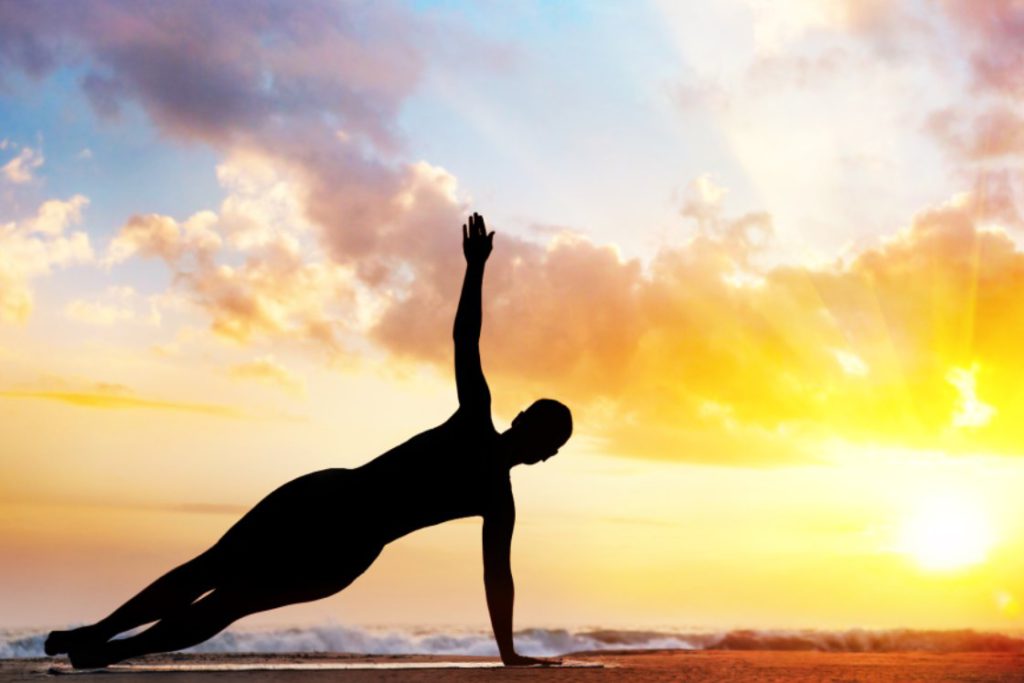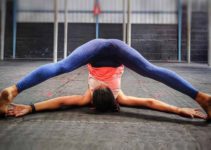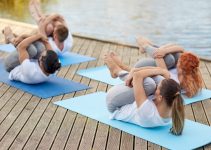
Are you struggling to find balance while leaving your comfort zone? Or is it about finding strength and alignment within the body? Whatever the reason, vasisthasana aka side plank pose is your call at the moment.
To come into this pose, from the plank pose the practitioner shifts the body weight towards one side by rotating the body and balancing it on the corresponding hand and foot. The alternate leg is pulled with the hand vertically up.
The challenge and strength involved in this pose make it an intermediate asana. It focuses on strengthening the arms, shoulders, and core muscles. Besides these, it targets to improve spinal alignment and body balance.
Read this step-by-step guide to perform vasisthasana and find physical as well as mental balance.
Vasisthasana Meaning
In Sanskrit, ” vasistha” refers to “wealthy” and “asana” means “pose”. It is appropriately named so since it provides abundant benefits to the yogi. it enriches the health by providing stability in mental and physical health.
It is often known by its English name, side-plank pose. As the yogi performs the plank on one side of the body, opening the chest, hence the name.
Mythological aspect leading to vasisthasana
This asana is named after the great Indian sage, Vasistha who was the family priest of the Ikshwaku dynasty. Lord Rama was one of his disciples who once felt depressed after visiting the common people of his kingdom and their sufferings.
This incident made Vasistha guide his disciple Rama towards the reality of life. He told him not to get trapped in the outside sufferings by getting control over the mind to feel liberated and self (the soul).
It leads lord Rama to once again open his heart after the dark and depressing phase he went through. This is what vasisthasana, all about.
It opens the heart (Anahata chakra) of the practitioner as he/she switches from the low plank to side plank pose, opening the chest and finding balance within the body.
Vasisthasana Practice Guide

Precautions & Contraindications
- Avoid this pose in case of any injury in the arms, legs, neck, and back.
- Skip this practice if you are recovering from a recent surgery.
- People with any issue in the chest, ribcage, or shoulders must refrain from this pose.
- If you have a herniated disc or rheumatoid arthritis, do not try the side plank pose.
- It is not a suitable pose with issues like carpal tunnel syndrome, tendinitis, bursitis, etc.
- Pregnant women should only perform it with the help of props and with proper caution.
Preparatory Poses
- Downward-Facing Dog Pose (Adho Mukha Svanasana)
- Half Moon Pose (Ardha Chandrasana)
- Plank Pose (Phalakasana)
- Wide-Legged Forward Bend (Prasarita Padottanasana)
- Reclining Hand to Big Toe Pose (Supta Padangusthasana)
- Reclining Hero Pose (Supta Virasana)
How to Do Vasisthasana (Steps)
- Stand in tadasana.
- Then bring your palms to the floor and legs back about 4-5 feet, assuming the plank pose.
- Slightly lift the right hand to place it ahead of your right shoulder.
- Pressing the right palm to the floor turn the body sideways to the right.
- The outer edge of the right foot is placed on the floor and the left foot is stacked over the right. Also, the left hand is lifted off the floor and rests on the left hip.
- Balance the entire body weight on the right hand and foot.
- Exhale, flex the left leg at the knee and bend the upper body slightly to reach the left big toe.
- Wrap the left hand’s thumb, index, and middle finger around the left big toe.
- Pull the left leg up vertically straightening the left arm and rotating the head to the right fixing the over the ceiling.
- Hold the pose for about 20-30 seconds with deep breathing.
- Then, release the big toe to bring the left foot back on the right foot, and the left hand to the hip.
- Exhale, turning the body to the center and then to the left.
- Repeat the pose balancing the body on the left foot and hand only.
- Come back to the center to the downward dog and finally relax in balasana.
Follow-up Poses
- Handstand Pose (Adho Mukha Vrksasana)
- Downward-Facing Dog Pose (Adho Mukha Svanasana)
- Four-Limbed Staff pose (Chaturanga Dandasana)
- Feathered Peacock Pose (Pincha Mayurasana)
- Supported Headstand (Salamba Sirsasana)
- Warrior II Pose (Virabhadrasana II)
- Extended Side Angle Pose (Utthita Parsvakonasana)
- Extended Triangle Pose (Utthita Trikonasana)
Props and Modifications
Side plank pose can be modified using the following props;
- Chair – While holding the side plank take support from the chair to rest the side body. It eases the pose and requires less strength.
- Ball – You can also use a ball rather than a chair. Just roll on the ball from the plank pose, resting the side on it.
- Yoga strap – If grabbing the toes in the side plank is troubling you, bind a strap around your raised big toe. Then you can hold the strap to stretch the leg up along with stretching the arm.
- Against a wall – Beginners find a wall to be the best prop. Perform the plank near a wall, as you roll on one side press the back and heel towards the wall. This adds support to hold the pose.
Variations

- Vasisthasana Twist – From the stacked position, bend the left knee to place the left foot on the floor. The legs are crossed so that the left foot lies beside the right thigh and the right leg is kept straight as in vasisthasana. Raise the left arm and shift your gaze towards the raised hand.
- Vasisthasana variation tree leg – After stacking the left foot over the right slide your left foot to place it over the right thigh. Raise your left arm towards the ceiling and look towards your left hand.
- Forearm Side Plank – Begin with forearm plank pose. Take your right forearm and place it parallel to the front edge of the mat. Stack the left leg over right with the outer edge of the right foot to the floor. Lift your left arm off the floor and extend it towards the ceiling opening the chest to the left.
- Vasisthasana variation raised leg – From tabletop position straighten your left leg with toes on the floor. Bring your left hand on the hip. Balance on the right hand and slowly lift the right foot off the floor straightening the knee. Extend the right leg forward and right hand up to the ceiling.
- Vasisthasana crunch – From vasisthasana with the left leg over the right, lift the left leg and bend the knee. Rest the left elbow on the left knee with a forearm extended upward.
Therapeutic Applications
- Vasisthasana is the most suitable pose for people to get rid of scoliosis. [efn_note] Serial Case Reporting Yoga for Idiopathic and Degenerative Scoliosis https://journals.sagepub.com/doi/pdf/10.7453/gahmj.2013.064 [/efn_note] The side-plank helps to lessen the curvature in the spine and strengthens the muscles.
- Another application of vasisthasana is found in treating people suffering from stress. The balancing posture improves the focus of the practitioner by clearing the mental blocks.
Vasisthasana Benefits
1. Tones the arms, shoulders, legs
Side plank pose is all about balancing on one side at a time. The entire body is balanced on an arm and leg at a time. It exerts pressure on the muscles of arms, shoulders, and legs. This tones the involved muscles and strengthens them.
2. Enhances core strength
The arm balancing posture engages the core muscles to find balance. It builds endurance and tones the core muscles. A study shows practicing this pose eventually makes the core muscles stronger [efn_note] Anatomical Correlation of Core Muscle Activation in Different Yogic Postures https://www.ncbi.nlm.nih.gov/pmc/articles/PMC5433114/ [/efn_note].
3. Improves balance and concentration
Performing vasisthasana on each side stretches the spine equally on both sides. This leads to better functioning of the brain providing stability.
The strength in the spine and improvement in the nervous system leads to better balance and concentration power of the mind.
4. Benefits the heart
The chest is opened to one side while holding the pose. It activates the heart chakra (Anahata).
It improves cardiovascular health as well as brings self-love, compassion, and forgiveness.
5. Builds self-confidence
While working on the core muscles, vasisthasana stimulates the Solar plexus (Manipura chakra). It is associated with developing self-esteem, therefore the posture is a key to inculcate decisiveness and confidence.




